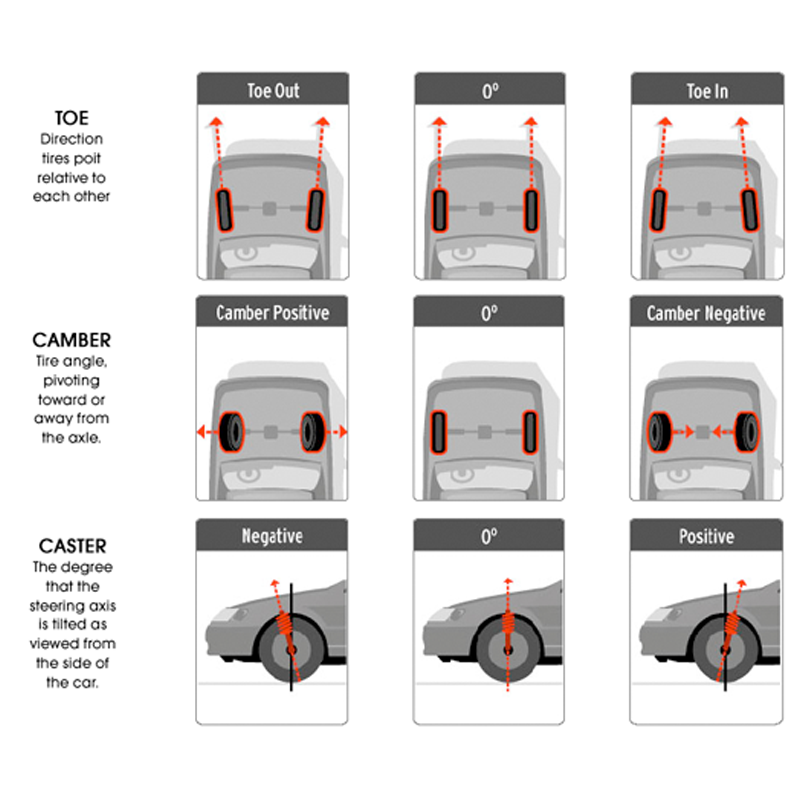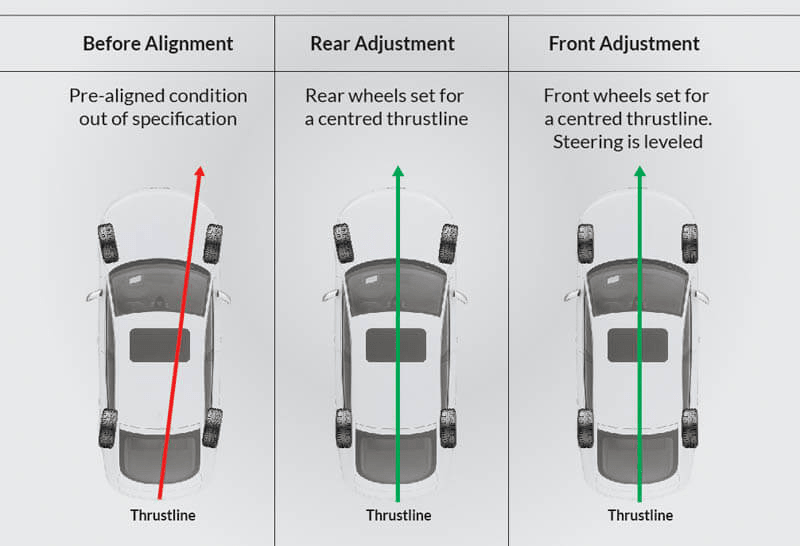Wheel Alignment - Steering Geometry
What is Wheel Alignment?
Wheel alignment is the process of ensuring that the geometry of a vehicles steering and suspension components are correctly setup so that the vehicle travels straight and true. The correct positioning of your vehicles wheel alignment is also essential to the longevity of life of steering/suspension components and tyres.
What causes your cars wheels to become misaligned?
There are a variety of factors that can leave your vehicle in need of wheel alignment these include component wear/failure and
accident/impact damage.
The correct wheel alignment settings for any particular make and model of vehicle are clearly outlined by specific vehicle manufacturers, the purpose of a steering geometry check is to set up the vehicle as close as possible to the manufacturer's guidelines.
What is Caster (negative and positive)?
Caster is the angle how far forward or back the steering axis is to the vertical axis when viewed from the side.
Negative caster is when the steering axis is forwards of the vertical axis.
Positve caster is when the steering axis to the rear of the vertical axis.
Vehicles are set with positive caster angles to promote true straight ahead feel and stronger self centre. The left and right caster should be equal in order for a vehicle to be able to travel/track in a straight line.
If the vehicle does not have enough positive caster the the vehicle steering can become twitchy at speed and the steering wheel may not return to the straight ahead position when coming out of a turn. When a vehicle has unequal caster it will manifest itself by the vehicle drifting to one side or the other, whichever direction the vehicle leads to will typically have the least amount of positive caster.
What is Camber? (negative & positive)
Camber is the vertical angle of the wheels compared to the vertical angle of the vehicle from head on.
Most vehicles will have a neutral or negative camber angle, visually this can be identified by the top of the wheel being closer to the centre of the car than the bottom.
How does Negative & Positive Camber Affect Wheel Alignment?
How does Negative & Positive Camber Affect Wheel Alignment?
Negative camber angle promotes better cornering and handling.
Positive camber angle allows for lighter steering but reduced handling and cornering.
Excessive camber either way can produce excessive wear to the inner our outer edges, the amount of tilt is measured in degrees from the vertical. When side-to-side camber is out as line by as little as 1° or more then this will cause the vehicle to pull to the side.

What is Toe? (Toe In or Toe Out)
Toe is the measurement of the wheels in relation to the direction they are traveling in. Toe measurements are usually neutral or close to neutral. Negative toe is an external rotation and positive toe is an internal rotation.
The purpose of toe is to ensure that the wheels roll parallel. Toe also serves to offset the small deflections of the wheel support system that occur when the vehicle is rolling forward. Improper toe adjustment will cause premature tyre wear and cause steering instability.
What is Toe out on turns?
Toe out on turns is the toe angles when turning. The Ackerman theory determines the inner wheel should turn two degeees further than the outer wheel when turning.
What is Thrust Angle?
Thrust angle is the angle of an imaginary line running down the centre of the vehicle which should run parallel between the rear wheels and the front. Positive and negative thrust angle can be determined by the angle between the thrust line and centreline.
Measured from the rear:
A postive thrust angle is to the right of the centre line.
A negative thrust angle is to the left of the centre line.
The angle can be determined by the position of the rear axle or adjusted by the toe to as neutral position as possible.

What Causes the Thrust Angle to Become Misaligned?
There are a few factors that could cause thrust angle issues but it is common when the vehicle has been involved in a collision.
Misaligned thrust angle causes the vehicle to steer off centre because the rear wheels are not correctly aligned with the front wheels. An incorrect thrust angle will result in an off centre steering wheel and can also cause uneven front tyre wear even though the issue is to the rear.
What is Steering Axis Inclination (SAI)?
SAI or King Pin Inclination is the angle formed by a line that runs through the upper and lower steering pivots with respect to vertical.
Viewed from the front, SAI is also the inward tilt of the steering axis. Like caster, it provides directional stability. But it also reduces steering effort by reducing the scrub radius.
A vehicles steering axis inclination SAI is a built-in at the factory non-adjustable angle. It is used with camber and the included angle to diagnose damaged components.
What is Included Angle?
The included angle is the sum of the SAI and camber added together. The angle cannot be measured but should match side to side.
What is Set Back Negative and Positive?
Setback is the position of the wheels side to side. If the RH wheel is further back than the left then this is positive. If the LH is further back then that is negative
Setback can be correctly measured when both of the vehicles are in the straight ahead position and is used as a helpful in correctly diagnosing along with caster whether the vehicles chassis may be bent/misaligned as a result of a collision.
What is Ride Height?
Ride height is identified as the distance between a manufacturer specified point from a motor vehicles chassis, suspension components or body shell and the road surface. checking the vehicles actual ride height against the vehicle manufacturers guidelines is the correct working method of assessing the height of a vehicles springs this is important the vehicles ride height has a direct affect on camber, caster and toe settings.
